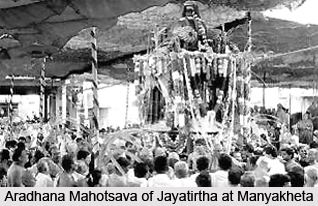 Manyakheta is situated along the banks of Kagina River in the Gulbarga district of the Indian state Karnataka. It served as the capital of Rashtrakuta dynasty from 818 to 982. It is the present day Malkhed and hosts one of the biggest cement factories of the country namely Rajashree Cements owned by the Aditya Birla Group. Over years the village has gradually emerged into a business centre for livestock trading, dairy and food grains. In fact is the credited as the biggest livestock trading centre in the region. Rain-fed crops are the prime crops which grow here and comprise different variety of pulses such as blackgram, greengram and pigeonpea. Although Malkhed has abundant water supply, it is not much utilized for agriculture. There are stone masonries here with thatched roofs made of square stone blocks placed in a slanting manner. This arrangement makes the draining of rain water easy. The place also houses a historical fort which is undergoing restoration work.
Manyakheta is situated along the banks of Kagina River in the Gulbarga district of the Indian state Karnataka. It served as the capital of Rashtrakuta dynasty from 818 to 982. It is the present day Malkhed and hosts one of the biggest cement factories of the country namely Rajashree Cements owned by the Aditya Birla Group. Over years the village has gradually emerged into a business centre for livestock trading, dairy and food grains. In fact is the credited as the biggest livestock trading centre in the region. Rain-fed crops are the prime crops which grow here and comprise different variety of pulses such as blackgram, greengram and pigeonpea. Although Malkhed has abundant water supply, it is not much utilized for agriculture. There are stone masonries here with thatched roofs made of square stone blocks placed in a slanting manner. This arrangement makes the draining of rain water easy. The place also houses a historical fort which is undergoing restoration work.
History of Manyakheta
Manyakheta gained prominence from 814 to 968 AD when during the rule of Amoghavarsha I (Nrupatunga Amoghavarsha) the capital of Rashtrakutas was shifted from Mayurkhandi located in Bidar district to Manyakheta. The ruler reigned for about 64 years and had authored the first classical Kannada work named Kavirajamarga. Amoghavarsha I along with scholars and intellectuals such as Jinasenacharya, Gunabhadracharya, Ajitasenacharya and Mahaveeracharya worked greatly to spread Jainism in the region. After the decline of Rashtrakutas, Manyakheta served as the capital of the Kalyani Chalukyas or Western Chalukyas, the successors, till 1050 CE. As per the Dhanapala`s Paiyalacchi, in CE 972 to 73 the Paramara king Harsa Siyaka captured the city.
Famous Institutions of Manyakheta
Manyakheta is the site of the Uttaradi Matha of the Dwaita School of philosophy of Madhvacharya. In a Brindavana located here, the remains of Sri Jayatirtha, a prominent saint, were buried. He was a commentator of Anuvyakhyana of Madhvacharya which presents commentary on the Brahma Sutras. The commentary was known as Nyaya Sudha and he was credited for converting Manyakheta as a centre of Madhva study. The Aradhana Mahotsava of Jayatirtha is organized every year at Malkhed in the Ashada month of Hindu calendar. The place is also famous for the Jain Bhattaraka Math, a temple of Neminath which dates back to 9th century AD. The idols of the temple comprise tirthankaras, Nandishwar dvipa and yakshi. There is also a celebrated panchdhatu shrine having 96 images. Other historical images also grace the temple. It is the place where the famous Mahapuranas (Adipurana and Uttarapurana) has been composed by Acharya Jinasena along with his pupil in the 9th century. Somodeva Suri`s Yasastilaka Champu has also been written here. Mahaviracharya had written the mathematics text Ganita Saara Sangraha here. Manyakheta has also been the residence of Apabhramsha poet Pushapadanta.



















